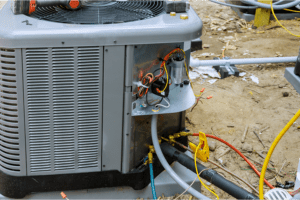If your air conditioner isn’t cooling as well as it used to, the problem might be with the fan motor or blower motor. Knowing how to service an AC system when replacing a motor can help get your AC unit back in shape without bigger headaches down the line. Let’s break it down with each step so you don’t miss a thing.
First Things First: Safety
These tasks should be done by professionals because safety is involved in them. This is how experts do it. Cut the power. Always shut off your AC unit at the breaker before touching anything. Electrical shock is no joke. Once it’s off, double-check the label on the old motor. This helps you find the right replacement part with the proper specifications. Incorrect specs can burn up the system or just not work at all.
It’s also wise to take a photo of the wiring connections before you begin. It’s easier than guessing later. Gather your tools, including a socket wrench, nut driver, and screwdrivers, along with a soft cloth and a multimeter for basic testing. Once again, we want to remind you that these jobs require professional experience and expertise, so always hire HVAC experts for safe results.
Remove the Fan Motor
Once the power is off and you’re safe, open the access panel or top grille. Most fan motors are attached to the grille, so you’ll be removing both the motor and fan blades together. Carefully loosen each set screw—don’t lose them. They’re small but necessary for proper installation.
Slide the fan blades off the shaft.
If they’re stuck, spray a little WD-40, let it sit, and try again. Bent or damaged blades can throw off your system, so inspect closely.
Inspect the AC Components
Before installing the new motor, professionals take time to inspect the surrounding AC components. They look at the AC compressor, evaporator coil, AC compressor clutch, and condenser coils. If they notice any dirt buildup, they clean it out using compressed air or a soft brush.
Dirty coils make the system work harder than it should, which can lead to breakdowns. Also, check the condenser fan blades for damage. A warped blade can hurt airflow and lower cooling performance.
Install the New Motor
Your new blower motor or condenser fan motor should fit into the same brackets as the original. Professionals place the motor in and slide the fan blades back onto the shaft. They then tighten each set screw securely. Most electrical components are color-coded but double-check the diagram or manual for your model. If you are doing it yourself, be sure not to pinch any wires when reinstalling the grille or panel. Damaged wiring can cause the system to short out.
Check AC Lines & Refrigerant
HVAC professionals inspect the AC lines, looking for signs of wear, blockages, or leaks. If there is oily residue or hears hissing, that might be a refrigerant leak. Also, if hot air is blowing from the vents, the AC compressor or compressor clutch might be in trouble.
Another thing to watch is the condenser coils. Dirty coils can cause overheating and reduce the performance of the HVAC system. A clean system is a happy system.
Test the New Setup
Once everything is reassembled, turn your power back on and test the AC system. If there is any rattling or squeaking, shut it down and inspect the installation again.
Check the airflow. Is it cool? Is it strong? If you still feel hot air, something could be off with the wiring, or the new motor might not be functioning as expected.
Don’t Forget the Little Things
It’s a great time to check other components. Are your vents free of dust? Are your filters clean? Sometimes, small issues compound over time. Keeping every piece of your HVAC system clean makes a big difference.
If your air conditioning unit still struggles, don’t keep guessing. You might save your time and money by having HVAC professionals take a closer look.
Call in the Pros: Always
DIY fixes are acceptable but not recommended. If your engine replacement gets complicated, or you’re unsure about wiring, it’s best to call in for an AC repair company. Mistakes with electrical connections can cost more than the repair itself. It’s also not safe as electricity is involved. A trained tech can also inspect deeper AC components you might not be able to access safely.
Final Thoughts
Understanding how to service an AC system when replacing a motor takes patience. From checking the motor and AC components to cleaning the fan blades and installing the new motor, each step counts.
Professional maintenance helps you avoid breakdowns and keeps your heating and cooling system running smoothly during hot days. If you’re ever in doubt, call your local HVAC professional to get the job done right. Stay cool, stay safe—and treat your air conditioner with the care it deserves!
Call Great Street HVAC for AC Repair & More
Dealing with a failing AC condenser fan motor? You’re not alone. Knowing how to service an AC system when replacing a motor can save you from bigger problems. Great Street HVAC handles it all—from AC installation and AC repair to full HVAC maintenance and furnace installation.
Need help with airflow? We also offer ductwork repair and Aeroseal ductwork sealing. We also offer heat pumps, furnace repair, and commercial HVAC services. Call us today to get expert service right when you need it.





